Art World
Spirituality Has Long Been Erased From Art History. Here’s Why It’s Having a Resurgence Today
With an Agnes Pelton show on the horizon at the Whitney, we investigate the trend for spiritually-minded art.
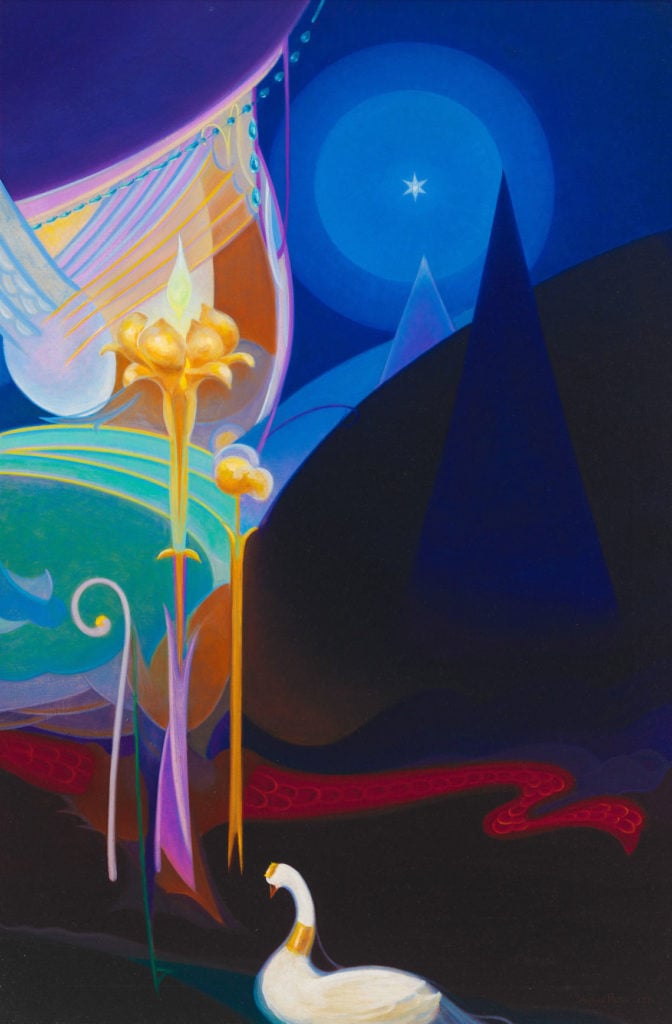
With an Agnes Pelton show on the horizon at the Whitney, we investigate the trend for spiritually-minded art.

Eleanor Heartney

What to do when, in the words of Karl Marx and Friedrich Engels, “All that is solid melts into air?” Times of upheaval inspire a search for alternative understandings of reality. This was as true a century ago as it is today. In a prefiguring of our own troubled moment, the rise of modern capitalism undermined long established social systems while new scientific discoveries challenged long accepted religious beliefs. Then, as now, those dissatisfied with mechanistic explanations of life and society had two choices: retreat back to now discredited philosophies or seek other ways of understanding the forces reshaping human life.
In the late 19th century, two phenomena emerged from this confusion. Many of the era’s leading thinkers embraced the new science while rejecting a purely materialist vision of human existence. At the same time, artists moved beyond conventional representational strategies toward a radical new approach to art. In 1986, a now legendary exhibition at the Los Angeles County Museum of Art proposed a link between these two developments. “The Spiritual in Art: Abstract Painting 1890–1985” challenged prevailing formalist histories of modernism by tracing the origins of Western abstraction to a confluence of ideas about spirituality current at the turn of the last century.
Maurice Tuchman, the exhibition curator, threw down the gauntlet in the first line of his catalogue essay. He declared, “Abstract art remains misunderstood by the majority of the viewing public.” In a sprawling exhibition of works by more than 100 artists, he presented both canonical figures and little known practitioners, early modernist masters and contemporary artists, in each case revealing deep connections to spiritual, utopian, or metaphysical beliefs.
At the time, his radical reconceptualization of the history of modernism landed like a thud. In 1998, author Charlene Spretnak interviewed him about the show’s effect on art-world attitudes. He responded: “None, whatsoever.” But that assessment is no longer accurate. Where once it was, in the words of Rosalind Krauss, “embarrassing to mention art and spirit in the same sentence,” today it could not be more au courant.
Massimiliano Gioni’s 2013 Venice Biennale, titled “The Encyclopedic Palace,” was dedicated to spiritualist cosmologies of all kinds. Since that time, a steady drip of rediscoveries of art with occult themes has been felt. In 2014 and 2015, Marjorie Cameron (1922–1995), aka Cameron, had her occult art showcased at LA MoCA’s Pacific Design Center (“Songs for the Witch Woman”) and Jeffrey Deitch in New York (“Cinderella of the Wastelands”). A 2016 exhibition of British artist Georgiana Houghton’s “spirit drawings” at the Courtauld in London drew huge crowds, the same year that “Language of the Birds” at New York University’s 80WSE Gallery presented a cross-historical exploration of art inspired by Kabbalah, alchemy, hermeticism, and Tarot. Self-taught painter and telepathic healer Emma Kunz was featured at the Serpentine just last spring. And, of course, the Guggenheim’s Hilma af Klint show broke records for attendance last year—perhaps the moment it became clear to all that the new interest was truly a juggernaut.
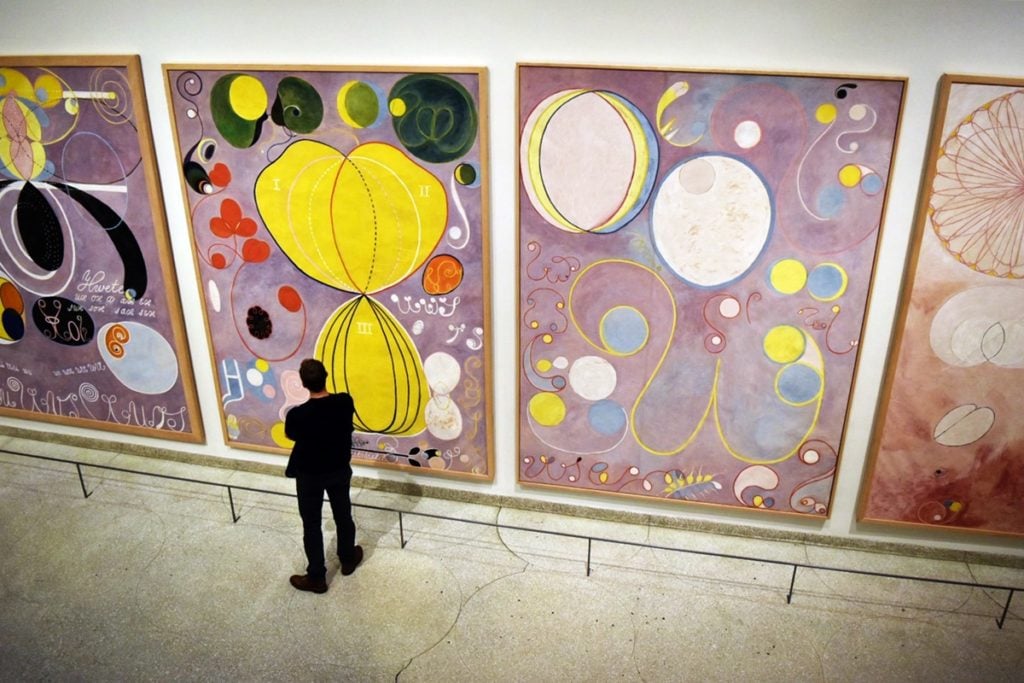
Installation view of Hilma af Klint’s “The Ten Largest.” Image courtesy of Ben Davis.
This build-up of exhibitions has shed a light on an important aspect of the modernist embrace of spirituality, a phenomenon that has to be views in a wider context. In the early modern era, the boundary between science and faith was far more porous than it is today. Charles Darwin, who did so much to shake the foundations of 19th-century religion, was adamantly opposed to the supernatural. Yet Alfred Russel Wallace, who simultaneously and independently conceived of the theory of evolution and was originally listed as its co-discoverer, was a true believer. His embrace of spiritualism may account for the degree to which he has been erased from the history of science.
Arthur Conan Doyle, now mostly associated with his creation of Sherlock Holmes, was a fervent Spiritualist and in fact devoted many more books to spiritualism than to his hyper-rational detective. Thomas Edison was keenly interested in occult motion and invented the telephone to talk to the dead. William James, one of the fathers of modern psychology, conducted experiments to confirm the existence of life after death and the persistence of spirit.
The receptivity of these and other 19th-century intellectuals to spiritual concerns was no doubt encouraged by new technologies and discoveries. The telegraph, x-rays, radioactivity, and the possibility of non-Euclidan geometry and a fourth dimension (after Einstein this came to be defined as spacetime) all seemed to confirm the existence of an invisible, non-material realm.
Conversely, even the wonkier proponents of the spiritualist view couched their ideas in scientific terms. Madame Blavatsky, founder of theosophy, a doctrine influential on many artists of the age, situated her synthesis of Hinduism and Buddhism within the scientific world, applying the new concept of evolution to the spiritual evolution of humanity. Rudolf Steiner’s anthroposophy, an outgrowth of and reaction against theosophy, was also concerned with psychic and cosmic evolution to be achieved by the application of what he called “spiritual science.”
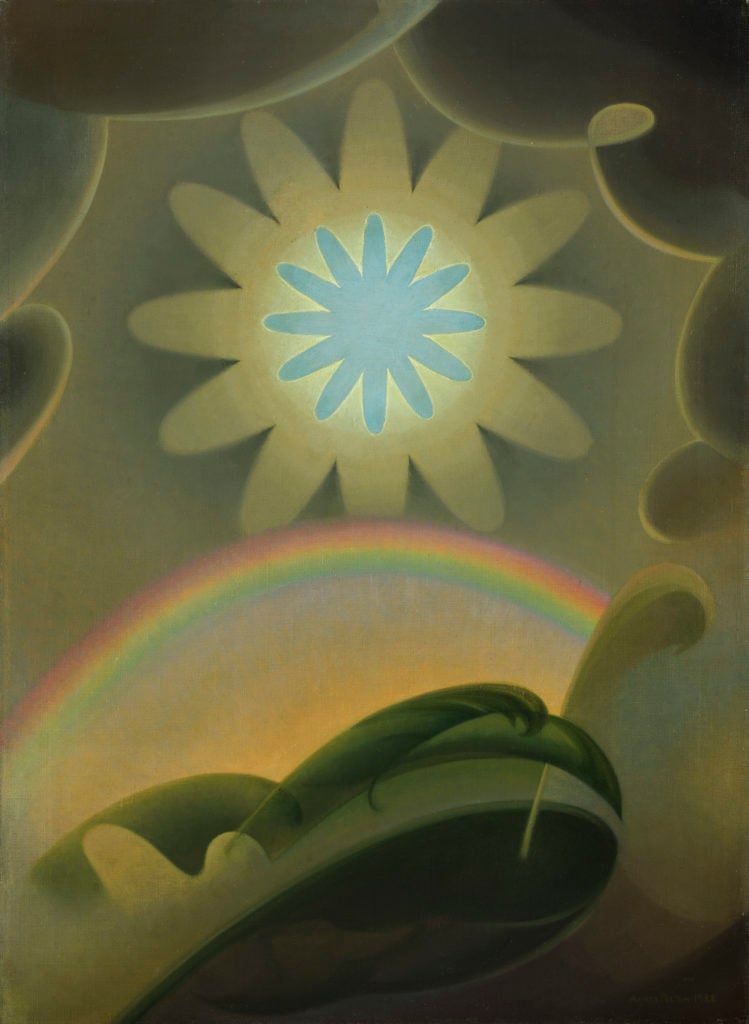
Agnes Pelton, Sand Storm (1932). Photo by Edward C. Robison III, courtesy of the Crystal Bridges Museum of American Art, Bentonville, Arkansas.
What has until now been underappreciated is just how pervasive such ideas were, especially among the artists who formed the modernist avant-garde.
In her 2014 book, The Spiritual Dynamic in Modern Art, Charlene Spretnak expands on the ideas in Tuchman’s “The Spiritual in Art” exhibition, taking it beyond abstraction to suggest the spiritual underpinnings of a wide swath of modern and contemporary artists. Her book, based on painstaking research into the motivations of artists from 1800 to the present, proposes a radical revision of our understanding of the history of modernism. Spretnak argues that spirituality is at the heart of the established canon and that mystical and occult ideas run through the works of artists as diverse as Kandinsky, Malevich, Mondrian, Beckman, Miró, Dove, and Klee.
Spretnak builds her argument around broadly recognized artists. The exhibitions cited above, by contrast, focus on figures who have been more marginal to art history. As a result, there has been some debate about their legitimacy as artists.
Hilma af Klint, for example, was an established and recognized member of the Swedish art community. However, the works for which she is now being celebrated were done privately, as part of her involvement with a group of four other spiritually inclined women, created at the direction of a spirit guide. These paintings, which the spirits decreed should be displayed in a specially designed temple, would provide knowledge necessary for the coming New Age. Anticipating critical hostility, af Klint decreed that her works of visionary geometry were not to be unveiled to the public until 20 years after her death. In fact, it took more than 40 posthumous years for these works to enter the art discourse through Tuchman’s 1986 exhibition.
The paintings were unlike anything being done at the time. Their spirals, circles, calligraphic notations, and esoteric symbols were deeply indebted to af Klint’s study of theosophy. As a result, even today the curators of the Guggenheim show seem uncertain how to situate this work. In a round-table discussion published in the exhibition catalogue, a group of eminent writers, artists, and curators debate questions about af Klint’s intentionality, the authorship of works produced under the influence of a spirit guide, and whether a painting that is a diagram of a higher reality qualifies as an abstraction. In the New York Review of Books, Susan Tallman raised similar issues, asking, “To what degree does celebrating these things as works of art, and celebrating af Klint as their creator, invalidate everything she was hoping to achieve?”
However, the notion of the artist as channel for otherworldly forces is hardly unique to Hilma af Klint. Artists as comfortably canonical as Whistler, Mondrian, Kandinsky, and Malevich were also inspired by theosophy and anthroposophy. None of them created the kind of “pure abstraction” extolled by mid-century critics. Kandinsky, for one, produced controlled explosions of color that bear a striking resemblance to images that appear in Thought-Forms, a standard theosophical text. Mondrian’s geometric compositions were meant to express the “dynamic equilibrium” of the immaterial realm. And, of course, the Surrealists were entranced by automatic drawing as a way to connect with the unconscious.
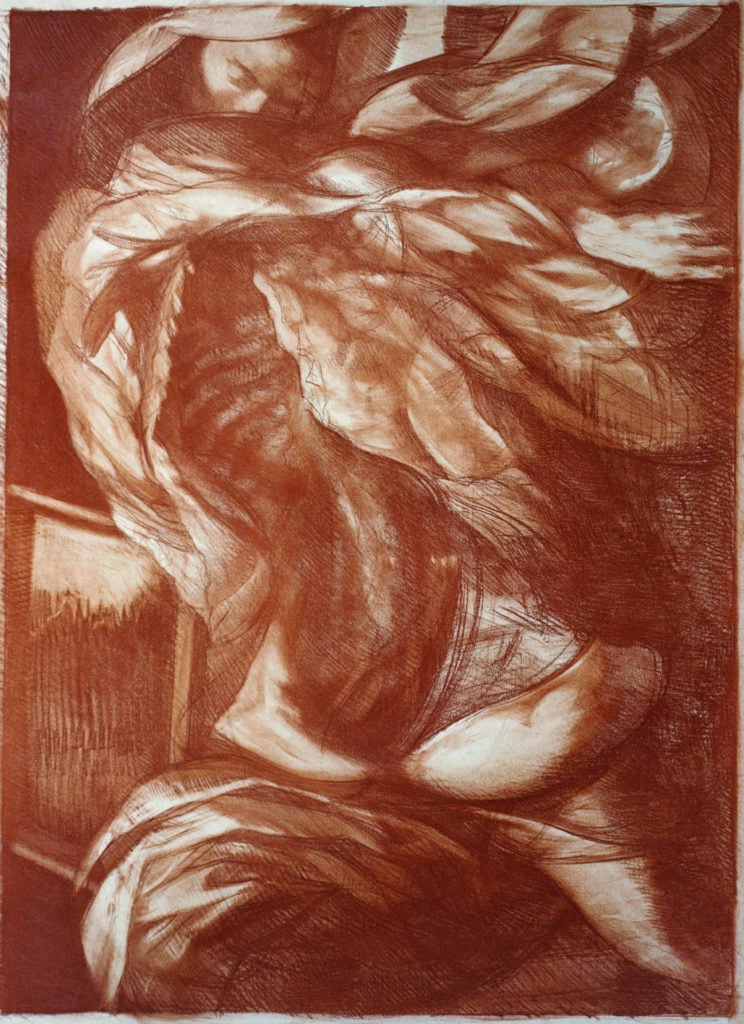
Hyman Bloom, Cadaver. Courtesy of Getty Images.
Agnes Pelton, whose work will be showcased at the Whitney Museum starting in March, has a clearer claim to conventional art history. Another follower of theosophy founder Madame Blavatsky, she was included in the 1913 Armory show before moving out west.
There, she joined a community of like-minded artists who shared not only her interest in spiritualism, but also her more liberal views on gender and sexual practice. Visitors to her Whitney exhibition will see dreamlike semi-abstractions that mingle evocations of desert landscapes with ethereal and vaguely representational forms.
Pelton was concerned with the metaphysical properties of color and their ability to bring the viewer into a state of enlightenment. In Enchanted Modernities: Theosophy, the Arts, and the American West, a new book on Spiritualist movements, she is quoted as saying, “These pictures are like little windows opening to the view of a region not yet much visited consciously or by intention—an inner realm, rather than an outer landscape.”
While Pelton has been little known outside the western US, Hyman Bloom was once prominent enough to be dubbed the “first Abstract Expressionist artist” by Willem de Kooning and Jackson Pollock. The artist, who was raised as an Orthodox Jew, fell out of the limelight for a variety of reasons. Not least of these was his involvement with spiritual concerns.
His paintings present jewel-like surfaces that are engulfed by a struggle between light and darkness. The work is indebted to a moment of mystical illumination he experienced as a young man during a period of extreme isolation and financial hardship. As he described it, “I had a conviction of immortality, of being part of something permanent and ever-changing, of metamorphosis as the nature of being.”
His recent show at the Museum of Fine Arts Boston, “Matters of Life and Death,” is centered on his paintings of cadavers, which, along with lushly painted near abstract representations of synagogues, rabbis, chandeliers, seances, and archaeological digs, were part of his exploration of the astral plane. This concept posits a state of being that exists between life and death and is informed by Bloom’s deep reading of theosophical texts, as well as his interest in mysticism, kabbalah, and other esoteric religions.
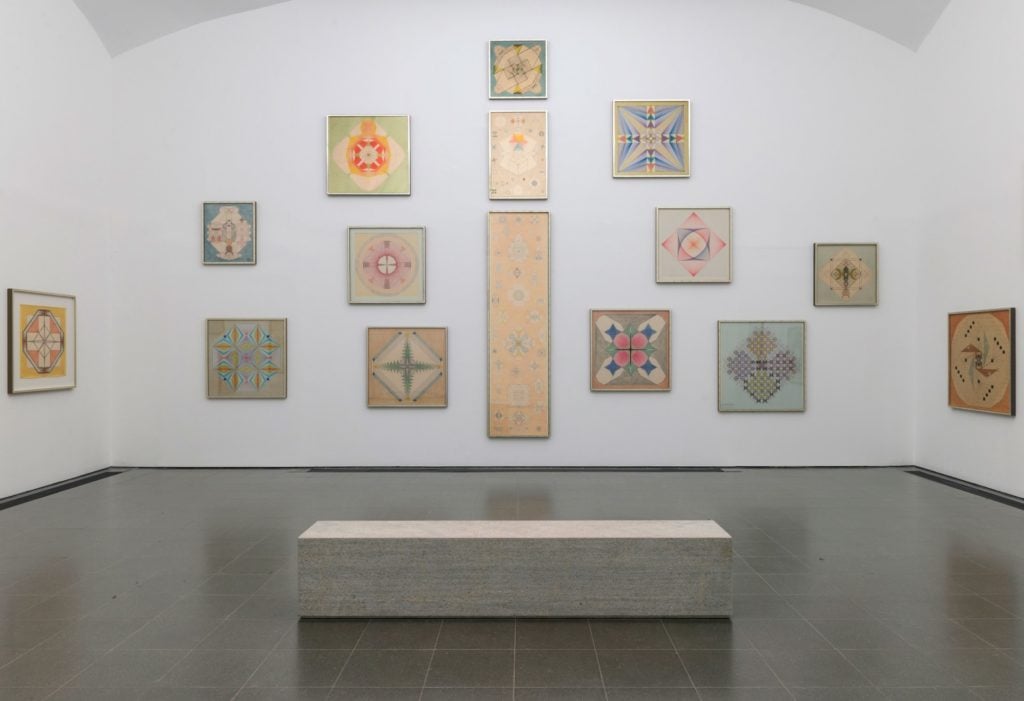
Installation view of “Emma Kunz – Visionary Drawings: An exhibition conceived with Christodoulos Panayiotou” at the Serpentine Galleries. Courtesy of the Serpentine.
Why are these figures, once quite marginal, moving into spotlight?
One explanation may be the breakdown of the canon under pressure from feminism and multiculturalism. Indeed, it is noteworthy how many of these artists are women or, like Bloom, members of marginalized groups. (While many Jews participated in the mid-century avant-garde, Bloom was unusual in his overt reference to his devotional practice.)
Another factor in the surge of interest may be a revulsion against today’s over-the-top commodification of art. There is something very appealing about art that resists the market through its appeal to secret knowledge.
But the new receptivity to spirituality also reflects our current state of upheaval. Once again, we face destabilizing forces, among them a yawning inequality that attests to the failures of neoliberal fantasies about the rationality of the market. New technologies like AI and ever more sophisticated corporate and government surveillance threaten our very sense of self and society. And there is widespread recognition that materialism has produced a climate crisis that may spell the end of life as we know it.
Once again, a search for alternatives has manifested itself in a surge of interest in spiritual and spiritualist concerns. Astrology, the New Yorker notes, is hot right now. The New York Times reports that millennials are very into witches and “witch parties.” But along with astrology, the occult, magic, and alchemy, the new spirituality also manifests itself in a longing for restorative politics, and human-centered social attitudes.
Who are the contemporary equivalents to af Klint, Pelton, or Bloom? Today plenty of artists are willing to cop to spiritual influences on their work. Some go further, attempting to channel unconscious or even supernatural energies through drugs, hypnosis, or seances. Yet others seek portals through technology. In place of the spiritual progress promised by esoteric philosophies like theosophy and anthroposophy, they grapple with the Singularity and its assertion that artificial intelligence is the next state in (non)human evolution. Though none of this has yet gelled into a recognizable movement, it would seem that contemporary art and the spirit have once again made a tentative peace.